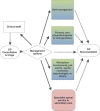A conceptual framework for increasing clinical staff member involvement in general practice: a proposed strategy to improve the management of low back pain
- PMID: 30791876
- PMCID: PMC6383226
- DOI: 10.1186/s12875-019-0923-x
A conceptual framework for increasing clinical staff member involvement in general practice: a proposed strategy to improve the management of low back pain
Abstract
Background: Low back pain affects about 80% of all adults, many of whom consult general practice. Providing management can be challenging, in part due to the scarcity of effective treatment methods. There is broad consensus in international clinical practice guidelines to provide patients with information about the nature of their pain and recommend them to stay active despite discomfort. Delivering this information is time-demanding and challenged by the limited available resources in general practice in many countries. Furthermore, general practice settings are highly variable in size and in their composition of clinical staff members - which presents difficulties, but also opportunities for developing alternative approaches to clinical management. Expanding the patient consultation time by involving clinical staff members (aside from the general practitioner) has been found feasible for other conditions. We propose that this approach is applied for non-specific low back pain. Consequently, we suggest the involvement of clinical staff members as part of a new strategy for managing low back pain in general practice.
Main text: Multifaceted implementation strategies have the potential to effectively enable change in the clinical management of patients with low back pain in general practice if they are based on theory and are tailored to stake holders. Inspired by the Medical Research Council's guidance for complex interventions and the ChiPP (Change in professional performance) statement, we suggest applying the following two policy categories: organizational change (environmental/social planning) and service provision. This will involve attention to environmental restructuring, modelling, enabling, education, training, persuasion, and incentivising of general practices, with an over-arching strategy of involving clinical staff members in the management of low back pain.
Conclusion: This is a pre-clinical proposal of a multifaceted strategy to support the delivery of evidence-based treatment for patients with low back pain in general practice. As an original idea, we suggest it would be feasible to involve clinical staff members in the delivery of information and advice to patients, whilst the general practitioner remains responsible for diagnostic decision-making.
Keywords: General practice; Implementation; Low back pain; Organizational change.
Conflict of interest statement
Ethics approval and consent to participate
Not applicable.
Consent for publication
Not applicable.
Competing interests
The authors declare that they have no competing interests.
Publisher’s Note
Springer Nature remains neutral with regard to jurisdictional claims in published maps and institutional affiliations.
Figures

Similar articles
-
Nutrition advice in general practice: the role of general practitioners and practice nurses.Aust J Prim Health. 2011;17(2):202-8. doi: 10.1071/PY10101. Aust J Prim Health. 2011. PMID: 21645478
-
Promoting and supporting self-management for adults living in the community with physical chronic illness: A systematic review of the effectiveness and meaningfulness of the patient-practitioner encounter.JBI Libr Syst Rev. 2009;7(13):492-582. doi: 10.11124/01938924-200907130-00001. JBI Libr Syst Rev. 2009. PMID: 27819974
-
The future of Cochrane Neonatal.Early Hum Dev. 2020 Nov;150:105191. doi: 10.1016/j.earlhumdev.2020.105191. Epub 2020 Sep 12. Early Hum Dev. 2020. PMID: 33036834
-
Person-centred education and advice for people with low back pain: Making the best of what we know.Braz J Phys Ther. 2023 Jan-Feb;27(1):100478. doi: 10.1016/j.bjpt.2022.100478. Epub 2022 Dec 22. Braz J Phys Ther. 2023. PMID: 36657216 Free PMC article. Review.
-
The Global Spine Care Initiative: applying evidence-based guidelines on the non-invasive management of back and neck pain to low- and middle-income communities.Eur Spine J. 2018 Sep;27(Suppl 6):851-860. doi: 10.1007/s00586-017-5433-8. Epub 2018 Feb 19. Eur Spine J. 2018. PMID: 29460009 Review.
Cited by
-
Feasibility study on recruitment in general practice for a low back pain online information study (part of the ADVIN Back Trial).BMC Res Notes. 2020 Jan 10;13(1):24. doi: 10.1186/s13104-020-4894-8. BMC Res Notes. 2020. PMID: 31924258 Free PMC article. Clinical Trial.
-
Implementing a new physiotherapist-led primary care model for low back pain: a qualitative study of patient and primary care team perspectives.BMC Prim Care. 2022 Aug 11;23(1):201. doi: 10.1186/s12875-022-01817-5. BMC Prim Care. 2022. PMID: 35948876 Free PMC article.
-
Involving practice nurse and other assistant clinical staff members in the management of low back pain: A qualitative interview study from Danish general practice.SAGE Open Med. 2021 Aug 18;9:20503121211039660. doi: 10.1177/20503121211039660. eCollection 2021. SAGE Open Med. 2021. PMID: 34777804 Free PMC article.
-
Implementation strategies to improve evidence-based practice for post-stroke dysphagia identification and management: A before-and-after study.Int J Nurs Sci. 2022 Jun 18;9(3):295-302. doi: 10.1016/j.ijnss.2022.06.010. eCollection 2022 Jul. Int J Nurs Sci. 2022. PMID: 35891917 Free PMC article.
References
-
- GBD 2016 Disease and Injury Incidence and Prevalence Collaborators Global, regional, and national incidence, prevalence, and years lived with disability for 328 diseases and injuries for 195 countries, 1990-2016: a systematic analysis for the global burden of disease study 2016. Lancet. 2017;390(10100):1211–1259. doi: 10.1016/S0140-6736(17)32154-2. - DOI - PMC - PubMed
-
- Flachs EM, Eriksen L, Koch MB, Ryd JT, Dibba E, Skov-Ettrup L, Juel K. Sygdomsbyrden i Danmark – sygdomme (The burden of disease in Denmark). Copenhagen: Danish Health Authority. 2015. Available from: https://sundhedsstyrelsen.dk/da/nyheder/2015/~/media/00C6825B11BD46F9B06.... Accessed by 26 Mar 2018.
-
- NICE (National Institute for Health and Care Excellence). Low back pain and sciatica in over 16s: assessment and management. 2016. Available from: https://www.nice.org.uk/guidance/ng59. Accessed by 26 Mar 2018. - PubMed
-
- Wong JJ, Cote P, Sutton DA, Randhawa K, Yu H, Varatharajan S, Goldgrub R, Nordin M, Gross DP, Shearer HM, Carroll LJ, Stern PJ, Ameis A, Southerst D, Mior S, Stupar M, Varatharajan T, Taylor-Vaisey A. Clinical practice guidelines for the noninvasive management of low back pain: a systematic review by the Ontario protocol for traffic injury management (OPTIMa) collaboration. Eur J Pain. 2017;21(2):201–216. doi: 10.1002/ejp.931. - DOI - PubMed
Publication types
MeSH terms
LinkOut - more resources
Full Text Sources
Research Materials

